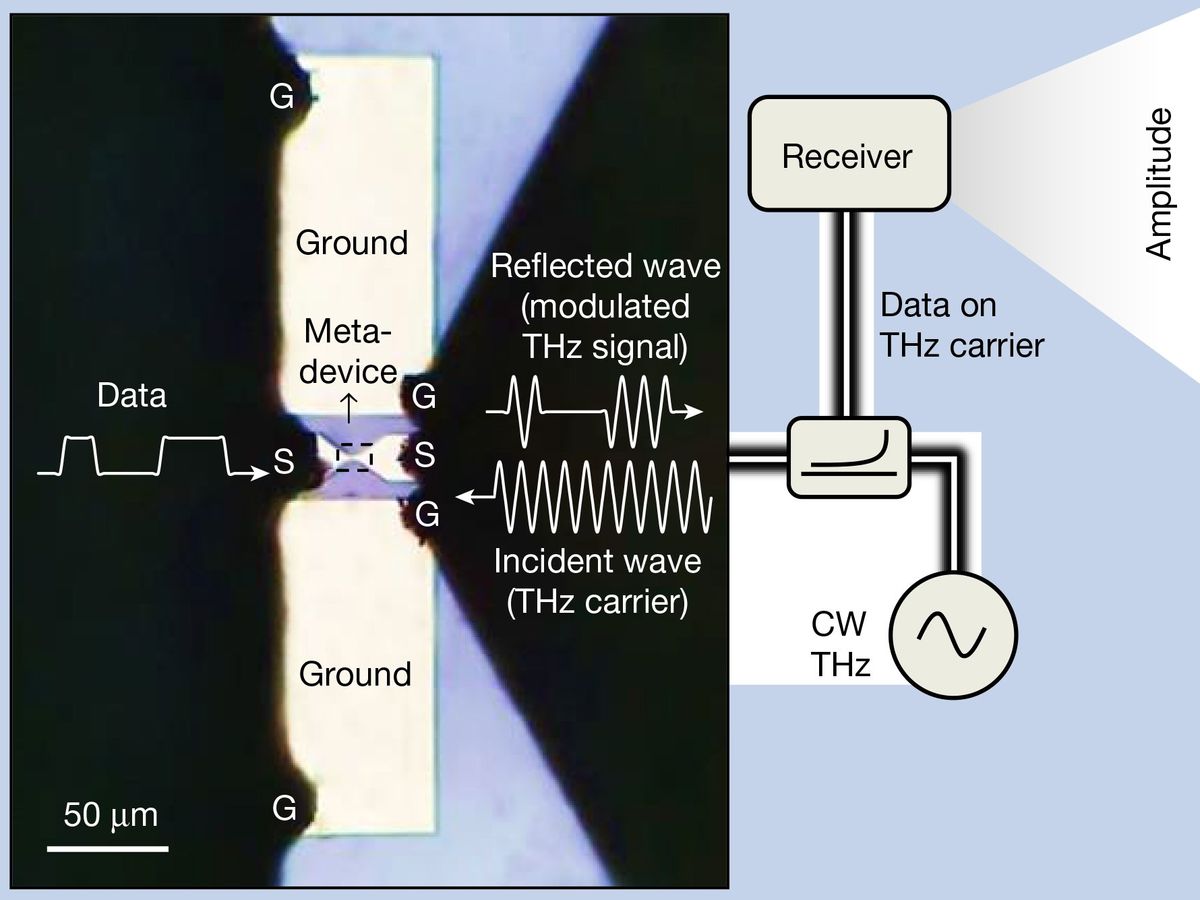Ultraquick telecommunications at terahertz frequencies are now possible using “electronic metadevices,” which may set the stage for the next generation of speedy gadgets. The way in which these novel devices control electric fields is similar to how invisibility cloaks manipulate light, heat, and sound, a new study finds.
As electronics shrink, following Moore’s Law, they face numerous challenges in terms of reaching practical applications. Often the problems these devices encounter result in significantly worse performance than what one might expect, given the potential of the semiconductor materials from which they are made.
For instance, smaller devices can hold only a few volts due to extremely high electric fields, which limits the maximum power they can deliver. In addition, the maximum operating frequencies of miniature gadgets is often drastically limited by unavoidable high parasitic capacitances. Moreover, state-of-the-art tunneling junctions, which are widely used in transistors and diodes, experience high contact resistance—that is, electrical resistance at their points of contact with other components—which limits the overall performance of devices.
To overcome these challenges, in the new study the researchers drew inspiration from recent extraordinary advances made with metamaterials, which are engineered to possess features not generally found in nature, such as the ability to bend light in unexpected ways. Such work has led to invisibility cloaks that can hide objects from light, sound, heat, and other types of waves.
Optical metamaterials, which are designed to manipulate light, possess structures with repeating patterns at scales that are smaller than the wavelengths of light they influence. In the new study, researchers developed devices that are similarly engineered, in that they possess structures smaller in scale than the wavelike collective electromagnetic interactions they are developed to control.
“We developed new kinds of devices that are alternatives to transistors and diodes and enable much higher speeds,” says study lead author Mohammad Samizadeh Nikoo, an electrical engineer at the Swiss Federal Institute of Technology, in Zurich. “We call this concept ‘electronic metadevices,’ and it can do much more than a normal device can do.”
In a conventional electronic device, one might find two rectangular terminals separated by a rectangular gap. In an electronic metadevice, one might instead see a pair of terminals each shaped like a key, with the teeth of one key fitting into the gaps of the other, and vice versa. The gap between these key-shaped terminals is zigzag in shape instead of straight. The precise size and other features of the components in an electronic metadevice help determine what frequencies it manipulates and what effects it has.
Normal electronic devices “are based on controlling electrons—there is a gate that either lets electrons go or forces them to stop,” Samizadeh Nikoo says. In contrast, electronic metadevices control microwave, millimeter-wave, terahertz, and other radio-frequency electromagnetic signals “without injecting a single electron,” he says.
The scientists note that this concept can generally apply to any semiconductor platform, including conventional CMOS systems, diamond, and recent 2D materials. “This new technology can change the future of ultrahigh-speed communications, as it is compatible with existing processes in semiconductor manufacturing,” Samizadeh Nikoo says.
These new devices may help overcome a major challenge that electronics now face with speed. Current wireless communications can use signals that are as fast as tens of gigahertz; future 6G communications need signals as fast as 1 terahertz. “Traditional electronic devices like transistors, however, cannot operate at such high speeds, which is often called the terahertz gap,” Samizadeh Nikoo says. “This is a major bottleneck in the development of future technologies.”
In experiments, the researchers created terahertz switches on a platform of indium aluminum nitride and gallium nitride. “We demonstrated data transmission at up to 100 gigabits per second at terahertz frequencies, which is 10 times higher than what we have today with 5G,” Samizadeh Nikoo says. “Our results show that electronic metadevices have the potential to operate even faster, enabling wireless links with terabit-per-second data rates, which can make a big impact in the way we communicate data and the way we process it.”
Conventional terahertz switches break down when pushed more than a few volts, “meaning that they are very sensitive to electrostatic discharge and they easily break,” Samizadeh Nikoo says. “Electronic metadevices are very robust and show breakdown voltages in a range of a few tens of volts.”
The new study found that electronic metadevices could outperform classical semiconductor devices in a number of other respects as well. For example, they display much lower contact resistance than tunneling junctions, which suggests electronic metadevices may find use not only as terahertz switches but also terahertz amplifiers, the researchers say.
“We can think of a new generation of semiconductor electronics with applications in ultrahigh-speed systems, such as 6G and beyond,” Samizadeh Nikoo says.
The scientists detailed their findings online 15 February in the journal Nature.
- Metamaterials Step Into the Light - IEEE Spectrum ›
- More Light From Metamaterials - IEEE Spectrum ›
- Metamaterials Could Solve One of 6G's Big Problems - IEEE Spectrum ›
Charles Q. Choi is a science reporter who contributes regularly to IEEE Spectrum. He has written for Scientific American, The New York Times, Wired, and Science, among others.



